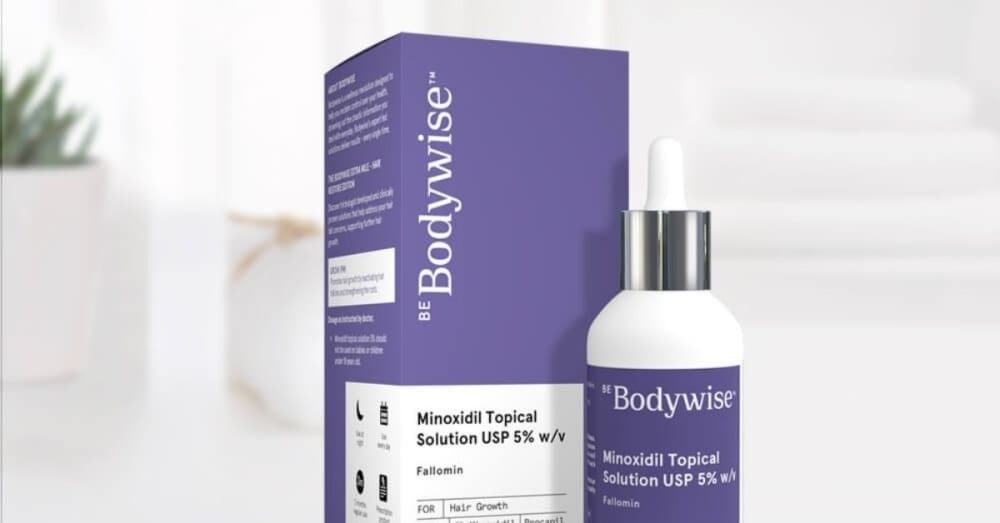Minoxidil for Women's Hair 101 ~ Everything to Know | Bodywise

Hair loss can be a sore spot for many people considering how difficult it is to grow them back. Even the smallest amount of hair loss can look significant to those with thin and light hair. Minoxidil for women is the only FDA-approved drug for female pattern baldness.
Who May Need Minoxidil?
Women with female pattern baldness or androgenetic alopecia can use Minoxidil for women. Some people lose more than 50-100 hair strands a day. Losing huge volumes of hair will require a long time for it to grow back.
The first sign of hair loss is the thinning of hair. It generally happens on the top or in the front of the head. This is where hair loss treatment becomes important.
Minoxidil for women can help reduce hair fall. It might even aid in growing the hair back.
How and Why Female Hair Loss Happens
Many reasons contribute to female hair loss. Here are some factors that can cause female hair loss:
1. Androgens
Regardless of it being a male hormone, androgen is also present in women ( in smaller quantities). For those who are genetically sensitive to hormones such as DHT (dihydrotestosterone), androgens might affect their hairline. However, this type of hair loss results from both genetics and hormone, which is why not everyone suffers from it.
Androgen-induced hair loss is gradual. It may take years or decades for the hairline and hair thickness to change gradually.
2. Postpartum
It is quite common to experience hair loss temporarily after giving birth. This is known as postpartum telogen effluvium. Research says that most women experience postpartum hair loss for about two and four months after giving birth. It can continue for up to six months even. In most cases, it does not go beyond 15 months.
3. Hormonal Fluctuations
Hormones play a role in hair growth and hair loss. Changes in hormones can affect hair thickness and health. The use of hormonal birth control or a change in birth control pills can cause hormonal imbalance.
4. Stress
It is possible to experience hair fall owing to physical or emotional stress. Someone who might have an incredibly stressful professional life or have experienced a traumatic experience might suffer from hair loss and hair thinning.
5. Autoimmune Diseases
The immune system sometimes targets hair follicles. This can encourage a loss of hair. This kind of hair loss is specifically called alopecia areata.
6. Nutritional Deficiencies
A poor diet may lead to hair loss. One must consume enough iron, protein, and other essential vitamins and minerals as a part of the diet. Hair health is severely affected by iron-deficient anaemia. This has led many women to experience noticeable hair thinning.
7. Medications
Certain medications may cause hair thinning and loss, such as antidepressants, cancer treatments, and medication for other serious diseases. This type of hair loss is generally temporary and will stop happening once the treatment ends.
8. Damaging Hairstyles
It is vital to understand the nature of the hair to know how to take care of the hair. Hairstyles and treatments, such as weaves, braids, or hot oil treatments, can cause thinning and damage the hair.

How Minoxidil for Hair Works to Stop Hair Loss in Women
Minoxidil helps by speeding up the hair's growth cycle. Hair follicles have four different stages of growth, including rest and shedding. The four stages are:
1. The Anagen Phase
This is the hair growth cycle's first phase. This phase entails the hair growing from being barely visible to its full length. This particular phase goes on for years as the hair continues to grow to its full length before it starts to detach and shed.
2. The Catagen Phase
This phase entails the hair follicle shrinking. Hair strands will then eventually detach from the scalp.
3. The Telogen Phase
This phase is the resting phase. Now, all the old hair on the head will rest while new hair begins to grow under the layers of skin.
4. The Exogen Phase
This phase is the shedding phase. The old hair will fall out, and the new hair will begin to break through the scalp and replace the old hair.
Those taking Minoxidil for women will notice these Minoxidil results female:
Simply put, Minoxidil works as a reactivate button that prompts dormant hair follicles to restart the growth process. A large body of scientific research backs Minoxidil. A 2014 study found that 5% of Minoxidil foam worked well for treating hair loss in women.
It is believed that Minoxidil for women prematurely puts hair follicles into the Anagen phase. Hair follicles will then quickly pass through the resting and shedding phases before they begin to regrow. The resting and shedding phases go quicker before entering the Anagen phase and stimulating new hair growth. The effect is a faster hair cycle.
Some other studies showed that 60% of women using Minoxidil report different levels of hair growth, compared to the 40% who were given placebos.
Also Read: Rice Water for Hair Benefits, 2x Hair Growth, Side Effects, Recipes, More
How to Use Minoxidil for Female Hair Loss
Using Minoxidil is fairly simple. To understand how to apply Minoxidil topically every day, here is how you do it:
In the morning, apply Minoxidil to the affected areas of your scalp. It's as easy as that!
Want to know how to use Minoxidil and if it's safe? You can safely use it with most hair products. You won't even have to make any major changes to your hair care routine.
However, before you start using Minoxidil for women, it is important to find out if it's the best option for your type of hair fall. This is how one can tell:
- If you are currently on medication that contributes to hair loss, such as an antidepressant or cancer treatment, talk to your doctor before starting Minoxidil as a hair loss treatment option.
- If you are losing hair due to nutritional deficiencies, anaemia, or other diet-related imbalances, fix your diet and improve your health. Ensure you consume all essential nutrients that contribute to healthy hair before you consider taking Minoxidil.
- If you are losing hair due to pregnancy, talk to your doctor before taking Minoxidil. Minoxidil falls under the Category C pregnancy risk category. This means there haven't been enough well-controlled human studies to figure out its pregnancy risk.

Pros & Cons of Using Minoxidil
Using Minoxidil for women has its pros and cons. They are listed below.
Minoxidil Pros for Women:
- Minoxidil is successful in slowing down or stopping hair loss for many women.
- Some women have experienced hair growth by using minoxidil.
- This is an over-the-counter medication. However, consult a healthcare professional before using it. Other medical conditions, such as thyroid dysfunction or nutritional abnormalities, may also have caused the hair fall.
- According to studies, minoxidil helps in treating hair disorders and promotes hair density in patients
- Studies also show that minxodil is effective in treating Androgenetic alopecia or female pattern baldness.
- The use of minoxidil stimulates blood circulation in small blood vessels and prompts hair follicles to grow hair again.
Minoxidil Cons for Women:
- It may cause unwanted hair growth, such as facial hair. This happens when the medicine trickles down your face. The risk is lower if you use the 2% concentration version of the medication.
- It may cause hair loss before it starts growing again in the first 2 to 4 weeks of using it. This is because the new ones are pushing out your old hair.
- This medication can take months to show any results. In most cases, it will only stop or slow down hair loss. It might take a minimum of four months before you see its effects. Even after that, very few women have hair regrowth.
- It may irritate your skin. You may notice some redness, irritation, or flaking on your skin.
Precautions You Need to Take While Using Minoxidil for Women
Here are the precautions to bear in mind while considering Minoxidil for women:
- Before using Minoxidil, inform your doctor or pharmacist of your allergies. Medication often has inactive ingredients, which may cause allergic reactions or other issues.
- If you have scalp diseases (infections, cuts, eczema, etc.), heart problems (heart attack, chest pain, etc.), kidney or liver disease, inform the doctor before using this product.
- Do not use this when pregnant unless a doctor recommends it. There is no information regarding it affecting breast milk. Go over the risks and benefits with your doctor.
Summing Up on Minoxidil for Women
While Minoxidil isn't a miracle solution, it still effectively addresses hair loss. It has had positive effects on women as a hair loss treatment option. While it can help treat hair loss, it might not work for all types of hair loss.
If you experience any side effects, contact your healthcare provider and stop using it immediately. As of now, Minoxidil for women is an easy and safe way to fight hair loss.
FAQs
Does Minoxidil Work for Women?
Yes, minoxidil works for women. it works by stimulating the growth phase of your hair follicles. As of now, Minoxidil happens to be the only FDA-approved drug to treat hair loss.
Who Should Not Use Minoxidil?
Not everyone can use this drug. If you are under 18 years of age, do not use it. Elderly individuals should also avoid using it as it may cause increased sensitivity to the cold. The topical solution may also present a risk to breastfeeding infants. Hence, lactating or pregnant women should not use this drug unless prescribed by the doctor.
Does Minoxidil Age Your Face?
NO, currently, there is no evidence or medical literature that proves Minoxidil is responsible for the ageing of the face.
Can We Use Minoxidil for PCOS Hair Loss?
Yes, you can use minoxidil for PCOS hair loss. But do note that Minoxidil helps manage hair loss due to PCOS, but will not completely cure it. Also, once you stop use it, the hair loss may re-occur.
References
- Claudine Piérard-Franchimont, December 2013; Alterations in Hair Follicle Dynamics in Women - https://www.ncbi.nlm.nih.gov/pmc/articles/PMC3884776/
- Aditya K Gupta, Kelly A Foley, December 2014; 5% Minoxidil: treatment for female pattern hair loss - https://pubmed.ncbi.nlm.nih.gov/25807073/
- Harvard School of Public Health, August 31, 2020; Treating female pattern hair loss - https://www.health.harvard.edu/staying-healthy/treating-female-pattern-hair-loss

